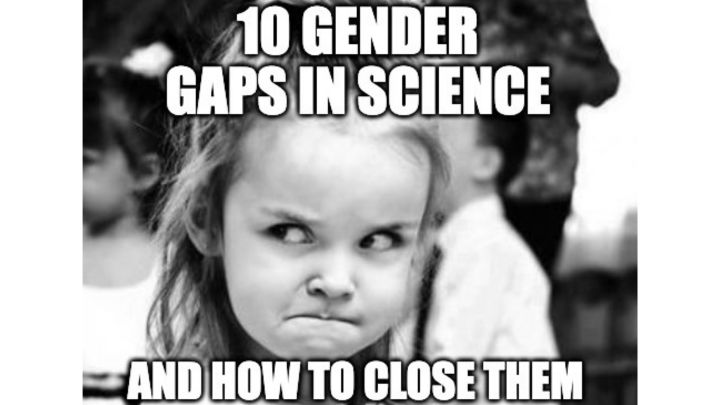10 gender gaps, 10 ways to close them
The gender gap [in science] is real. Despite significant progress, gender inequality continues to affect women and girls in various fields, especially in science. From funding to leadership, from recognition to work culture, women in science face barriers at every stage.

On this Women and Girls in Science Day, it's essential to reflect not only on the challenges we face but also on the actions we can take to create more equitable opportunities for women in research and education. This post highlights 10 key gender gaps in STEM and offers actionable ways we can help close them, ensuring a more inclusive and diverse future for science.
1. Representation gap
Globally, women represent only 33% of researchers, and their representation in senior academic positions drops to 15% or less in some fields. Source: European Commission, 2021
What can we do? Introduce mentoring programs and equity-focused hiring policies to support career progression for women, for example those that respect DORA principles and GEAR tools.
2. Access gap
Globally, girls are 3 times less likely to pursue STEM degrees. Social norms, stereotypes, and lack of encouragement discourage their participation. Source: UNESCO’s Cracking the Code: Girls’ Education in STEM 2017 and World Bank 2020
What can we do? Implement gender-sensitive teaching and role model campaigns showcasing successful women in science in K-12 schools and in Bachelors’ degrees.
3. Culture of care gap
Caregiving responsibilities disproportionately fall on women, with still 43% of female scientists reporting career setbacks due to family obligations.” In Departments and Institutes, Diversity, Equity, and Inclusion committee roles and their equivalent tend to fall on women, reducing their dedication to scientific tasks and projects. Source: Nature Careers Survey, 2021.
What can we do? Guarantee paid parental leave policies for both women and men, and introduce flexible research schedules and arrangements for caregivers, beyond the official parental leave period. Value Committee responsibilities and other academic leadership or community-building roles in faculty recruitment and evaluations.
4. Pipeline leak gap
Women are 2 times more likely to leave STEM careers, a survey from the US indictes, citing lack of mentorship, exclusionary culture, and harassment.
What can we do? Systematically create and enforce anti-harassment policies and invest in mentoring networks and career development strategies for women at all career stages. Involve and encourage women to take leadership role in grants early in their career.
5. Pay & funding gap
Globally, raw pay gaps exist as soon as graduates enter the labor market. In STEM fields, the first year, women earn, on average, 23% less than men. Over the next four years of their careers, the gap increases to 25.0%. Women also hold 4 times fewer research grants, limiting opportunities for larger-scale novel, well-supported research. Source: UNESCO in action for Gender Equality, 2020-2021 and Gender pay gaps across STEM fields of study and European Commission “She Figures” 2021
What can we do? Funders can adopt blind grant reviews and establish quotas for equitable funding allocation.
6. Leadership gap
In the EU, only 26% of leadership positions are occupied by women, with this representation falling to less than 15% in STEM, reflecting a severe lack of female leadership in science and academia. Source: European Commission “She Figures” 2021.
What can we do? Mandate gender-balanced leadership quotas and provide leadership training and rewards for occupying management positions for early- and mid-career female researchers.
7. Publication gap
In the EU, the number of men authors exceeds the number of women authors at all seniority levels. The ratio of women to men as authors is particularly evident in STEM fields, where over time the ratio of women to men for active authors moves from 0.8 to 0.5, reducing their visibility in science. Women are also corresponding authors on half as many research publications. Source: European Commission “She Figures” 2021.
What can we do? Establish more women-focused scientific awards grants and career progression rewards and highlight their contributions in global media.
8. Recognition gap
Since 1901, only 4% of Nobel Prizes in STEM have been awarded to women. For every 10 inventorships held by men, just over one inventorship is held by a woman. Source: European Commission “She Figures” 2021.
What can we do? Establish more women-focused scientific awards grants and career progression rewards and highlight their contributions in global media.
9. Women’s issues and perspectives gap
Medical and environmental research often fails to consider sex differences, leaving women’s health and other needs or experiences understudied and underfunded. Source: La investigación en medicina debe incluir el 50% de personas de cada sexo
What can we do? Mandate sex-disaggregated data in all studies and expand funding for female- or gender-focused specific research.
10. Intersectional gap
In studies conducted in the US, women of color represent less than 2% of tenure-track faculty in STEM, facing compounded racial and gender biases. In the UK, there were fewer 30 female professors of African-Caribbean heritage out of a total of 18,000 in the UK. Many countries do not even collect such data. Source: National Academy of Sciences, Engineering, and Medicine (2020). National academies press. And Where are the Black Female Professors in Europe?
What can we do? Fund fellowships for researchers of colors or for research on intersectional issues; Actively recruit researchers of color across all fields and career levels; Create and enforce career development and mentoring plans that support researchers of color; Work with K-12 schools in high-minority areas and with undergraduate departments to recruit minority students for scientific careers
This post was written by Ana Cañizares and led by Isabelle Anguelovski, head of Gender Diversity and Wellbeing at ICTA-UAB and who led the launch of the Gender Equity Plan as part of our commitment to gender quality at the institute.
Make sure to see our posts about it on Instagram, Twitter and Bluesky and join the conversation on social media using the hashtag #WomenInScienceDay.